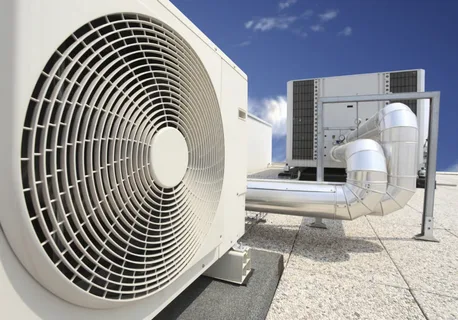Efficient Ventilation Systems | Improve Indoor Air Quality

Indoor air quality is a crucial aspect of healthy living. Breathing clean air is essential for our overall well-being. However, indoor air is often polluted due to various factors such as poor ventilation, dust, allergens, and chemicals. One solution to this problem is installing an efficient home ventilation system that will help to enhance indoor air quality. This blog post will explore the benefits of proper ventilation systems, the types of residential ventilation systems available, and essential considerations when choosing one.
Understanding the Importance of Indoor Air Quality
Indoor air quality is crucial for maintaining good health and well-being. Poor indoor air quality can lead to various health problems, including allergies, respiratory issues, headaches, fatigue, and irritation of the eyes, nose, and throat. These problems can be caused by pollutants such as dust, chemicals, and allergens that are commonly found in indoor environments. Therefore, it is important to understand the significance of indoor air quality and take steps to improve it.
Many people spend a significant amount of time indoors, making it even more crucial to have clean air to breathe. Children, the elderly, and those with pre-existing health conditions are particularly vulnerable to the effects of poor indoor air quality. Improving indoor air quality can reduce the risk of health problems and create a healthier living environment.
Ventilation systems play a crucial role in maintaining good indoor air quality. These systems help to circulate fresh air throughout the house, reducing the levels of pollutants in the air. They also help to control humidity levels, preventing the growth of mould and mildew. A properly designed ventilation system can make a significant difference in indoor air quality, creating a healthier living space for everyone.
The Role of House Ventilation system in Indoor Air Quality
House ventilation system play a critical role in maintaining good indoor air quality. The primary purpose of a ventilation system is to circulate air in and out of the house, replacing stale air with fresh air and reducing the levels of pollutants in the air. This is particularly important for people with allergies or respiratory problems.
A good ventilation system also helps to control humidity levels, preventing the growth of mold and mildew. High humidity levels can create an environment for mould and mildew to grow, which can harm health. Therefore, ensuring that the ventilation system is designed to control humidity levels effectively is important.
Additionally, ventilation systems help to regulate temperature, keeping the house comfortable throughout the year. In cold climates, the system can provide fresh air while retaining heat, reducing the need for heating. The system can handle high humidity levels in hot climates, keeping the house cool and comfortable.
Proper ventilation is also crucial for energy efficiency. A well-designed system can reduce energy costs by improving the efficiency of heating and cooling systems. This is because it can reduce the work required by these systems to keep the house at a comfortable temperature.
In summary, ventilation systems are critical to enhancing indoor air quality. They help to circulate fresh air throughout the house, control humidity levels, regulate temperature, and improve energy efficiency. When choosing a ventilation system, it is essential to consider factors such as the size of the house, location, climate, and cost. Regular maintenance is also crucial for the optimal functioning of the system.
Types of residential ventilation systems for Enhanced Air Quality
Several types of residential ventilation systems are available, each designed for specific purposes. The most common types of ventilation systems are:
- Exhaust ventilation: This ventilation system uses fans to extract stale air from the house. It is usually installed in areas such as the kitchen and bathroom, where moisture and pollutants accumulate. The system creates negative pressure, drawing fresh air into the house through gaps and cracks.
- Supply ventilation: This ventilation system brings fresh air into the house through fans. It is usually installed in areas such as bedrooms and living rooms, where people spend most of their time. The system creates positive pressure, pushing stale air out of the house through gaps and cracks.
- Balanced ventilation: This type of ventilation system combines exhaust and supply ventilation systems to provide a balanced fresh air flow into and out of the house. The system uses fans to bring fresh air into the house and extract stale air simultaneously. This type of system is ideal for homes in areas with moderate climates.
- Heat recovery ventilation: This ventilation system is designed for homes in cold climates. It uses fans to bring fresh air into the house while retaining heat from the extracted stale air. This helps to reduce the amount of energy required for heating the house.
When choosing a ventilation system, it is important to consider factors such as the size of the house, location, climate, and cost. Consulting with a professional can help you determine the best ventilation system for your specific needs. Choosing the right system can create a healthier living environment for you and your family.
The Benefits of Perfect Home Ventilation System Design
A perfectly home ventilation system design for your home offers several benefits to your well-being. Improving indoor air quality reduces the levels of pollutants in the air, which is particularly important for people with allergies or respiratory problems. A properly designed ventilation system also helps to control humidity levels, prevents mildew mold that could be harmful to your health. It regulates temperature, ensuring your living space is comfortable throughout the year. The energy efficiency of heating and cooling systems is improved, reducing energy costs.
Good indoor air quality is essential for healthy living, and proper ventilation systems are the key to achieving it. A well-designed system can create a healthy and comfortable living environment for you and your family. You can also enjoy several benefits, such as a reduced risk of allergies, respiratory issues, headaches, fatigue, and irritation of the eyes, nose, and throat. Your ventilation system will also keep your home comfortable while saving energy costs and minimizing the need for expensive repairs.
Essential Considerations when Choosing a Ventilation System
When choosing a ventilation system for your home, several factors must be considered to ensure you get the right one. The size of your home is an important consideration since larger homes require more robust systems than smaller ones. You also need to consider your house’s location since homes in areas with high pollution levels will require more efficient ventilation systems. Additionally, the climate of your area will determine the type of ventilation system that you need, with heat recovery ventilation systems being ideal for cold climates. In contrast, those in hot climates will require systems that can handle high humidity levels.
Cost is another factor to consider since ventilation systems can be quite costly to install and maintain. It is essential to choose a system that is cost-effective and efficient in the long run. Proper maintenance is crucial for optimal functioning once you have established a ventilation system. Regular cleaning of filters, ducts, and vents will prevent the buildup of dirt and dust, ensuring that the system works efficiently. It is also advisable to schedule regular maintenance checks with a professional to identify and fix any issues before they become major problems.
Overall, selecting the right ventilation system for your home is crucial for maintaining good indoor air quality and a comfortable living environment. By considering factors such as the size of your home, location, climate, and cost, you can decide on the best ventilation system for your needs. Additionally, regular ventilation system maintenance will ensure its optimal functioning and prolong its lifespan.
Proper Maintenance for Optimal Functioning of Home Ventilation Systems Australia
Proper maintenance of a ventilation system is crucial for its optimal functioning. Regular cleaning of filters, ducts, and vents will prevent the buildup of dirt and dust, ensuring that the system works efficiently. Over time, filters and vents can become clogged, making the system less effective at circulating fresh air and removing pollutants. This can decrease indoor air quality, which can negatively impact your health and well-being.
It is recommended to clean the filters and ducts of your ventilation system at least once a year. However, more frequent cleaning may be necessary depending on factors such as the type of system and the level of use. It is also important to schedule regular maintenance checks with a professional to identify and fix any issues before they become major problems. Professional maintenance can prolong your ventilation system’s lifespan and ensure that it operates efficiently and effectively.
In addition to regular cleaning and maintenance, addressing any issues with your ventilation system promptly is important. Unusual sounds, odours, or poor air flow could be signs of a problem that needs to be addressed. Ignoring these issues can lead to more significant problems and costly repairs.
Proper home ventilation systems Australia maintenance can help ensure that it operates effectively and contributes to good indoor air quality. By following these guidelines, you can create a healthy and comfortable living space for you and your family.
FAQs
1. How often should I clean home ventilation system?
Answer: It is recommended to clean the filters and ducts of your ventilation system at least once a year. However, depending on factors such as the type of system and the level of use, more frequent cleaning may be necessary. Regular cleaning of the system will prevent the buildup of dirt and dust, ensuring that it operates efficiently and contributes to good indoor air quality.
2. Can I install a ventilation system myself?
Answer: It is not recommended to install a ventilation system yourself. The installation process requires specialized knowledge and equipment, and mistakes can lead to safety hazards or inefficient operation. It is best to hire a professional to ensure that the system is installed correctly and safely. A professional can also provide guidance on selecting the best system for your specific needs.
3. How long do ventilation systems last?
Answer: The lifespan of a ventilation system depends on the type of system and how well it is maintained. Generally, a well-maintained ventilation system can last up to 15 years. Regular maintenance is crucial for ensuring that the system operates effectively and prolonging its lifespan. Neglecting maintenance can lead to costly repairs and the need for premature replacement. Therefore, it is important to schedule regular maintenance checks with a professional to identify and fix any issues before they become major problems.
Conclusion
In summary, a well-designed ventilation system is essential for maintaining good indoor air quality and a comfortable living environment. Poor indoor air quality can lead to a range of health problems, including allergies, respiratory issues, headaches, fatigue, and irritation of the eyes, nose, and throat. Therefore, it is crucial to understand the significance of indoor air quality and take steps to improve it. A well-designed and maintained ventilation system can help to create a healthier living environment, reduce energy costs, and prolong the lifespan of the system. By following the guidelines in this blog post, you can make an informed decision on the best ventilation system for your needs and ensure that it operates effectively to improve indoor air quality and your overall well-being.
| Related Business Listings |
| Contact Directory |
| Local Business Profiles |


 English
English 

